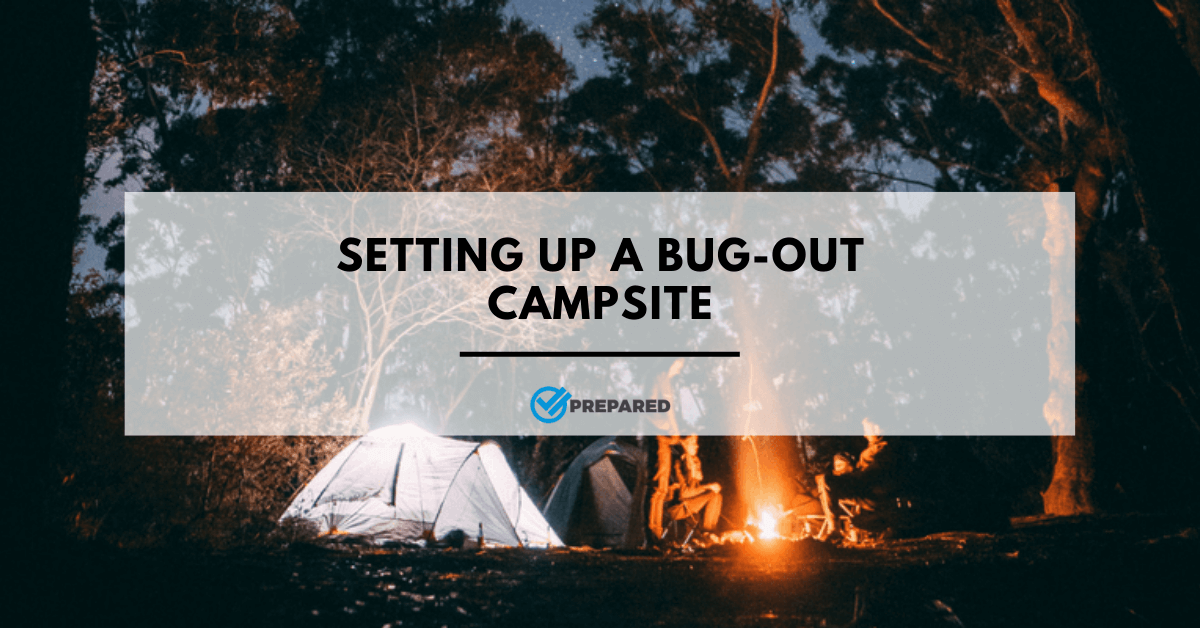We all want to think that the day will never come, but it does. Things have gone horribly wrong and you are forced to leave your home and go to a bug-out campsite. It could be due to a natural disaster like the flooding of Katrina or Harvey. It could be a pandemic sweeping across the country. It could be an economic collapse causing the government to instate martial law. Whatever the reason, you are doing the smart thing and leaving home.
Do not get me wrong. Staying in your home and bugging in is always your first preference in a disaster scenario. However, there must be a point where you know it is time to abandon ship. Thankfully you have done a little planning despite being new to survival and prepping.
You have a bug-out bag with basic supplies. You have also identified a large wilderness area just south of your home where you feel you can hide out until things blow over. You pack up your family and start hiking, but soon realize something. You do not really know where you are going. How far should you go from home? What are you looking for? How long will you be gone? In this article, we will cover how to identify a good bug-out campsite, how to set it up, and what gear might be helpful in a situation like this.
ALSO SEE: What is a bug-out bag?
Short Term versus Long Term Bug Out Campsite
When selecting a bug-out campsite, you must decide how long you plan to stay there. While many of your priorities will be the same either way, it is important to know if you will be sustaining your family for a few days or a few months. This requires a little bit of planning in advance. For our family, we have two potential bugout locations. One is close by and can easily be reached on foot within a day or two. The other is a few hundred miles away and is private land owned by my family.
We would likely stay for at least a week in our closest location and would only move to our further location if we felt we were not safe or that we did not have the resources we needed. This decision will help you determine how much time and effort you want to put into your bug-out campsite as you set it up.
Priorities for a Bug Out Campsite
There are several priorities to consider at any camp location. As you start to look for a place to stay, keep these things in mind:
Resources – When I look for a bug-out campsite, the resources available are my top priority. You want your camp to be close enough to water. This will make it easier to collect water or to go fishing. You want to have lots of downed timber in the area that can be used for firewood or for building a shelter. Ideally, you would like to have animals in the area, fish in a body of water, and wild edible plants in the area. Having these resources close will make your life much easier.
Camp Layout – The second consideration I have is the layout and location of the camp. You do not want your camp on high ground as it will catch the wind and also be more visible to others. You do not want it on low ground or too close to water because of flooding and insect populations. Predators also frequent bodies of water. You want to have level ground with little ground vegetation, so it is easy to set up a good shelter. There should be a few rocks in the area. Finally, a natural feature like a rock face or downed log can be part of your shelter and could save you time.
Security and Visibility – In many cases you have left home to avoid other people. This may be because they are sick, they are military, or they are looters. No matter the reason, you should choose your camp location with this in mind. It should be far from any regular roads or trails. It is ideal to have your camp deep in the woods, so it cannot be spotted from a distance or from the air. If you can use the physical features of the land to protect your camp, this would be another advantage. You can set up your camp next to a large rock face or a rushing river so that your camp is naturally protected.
Distance from Cities – As you leave your home and the city in which you live, there are always reasons to keep your distance. Cities are focal points where society will come unhinged. Diseases are more prevalent, looters more violent, and the chances of nuclear or chemical attacks are greater. I suggest you set up your camp at least 100 miles (160km) away from major cities and at least 50 miles (80km) away from smaller cities. This gives you a buffer zone so that you are less likely to be affected by the problems the city might face.
Climate and Natural Disasters – Particularly if you plan to stay at your camp for the long term, you should consider the climate along with the likelihood of natural disasters. For example, setting up camp in the Rocky Mountains right before winter could be a big mistake. When you are faced with several feet of snow and sub-zero temperatures, you will wish you found a warmer climate. Another example would be setting up camp along the coast of Florida or Louisiana. While the climate is wonderful, there is a good chance that flooding or hurricanes could become a major issue. If you have the option, pick a mild climate in an area that is less prone to natural disasters.
Setting Up Camp
Once you have found a location for your bug-out campsite, it is time to get everything set up. Pay close attention to the amount of daylight you have left. Your priorities might greatly change if you only have a couple of hours left. You can tell by using your hand. Hold up four fingers between the sun and the horizon. For every four fingers, you can fit between the two, you have one hour of daylight left.
ALSO SEE: Camping Checklist: Items to remember
Use the four pillars of survival to help you prioritize your setup efforts. These are food, water, fire, and shelter. Of these pillars, you absolutely need clean water and you need either a fire or a shelter. You would prefer to have both. Food can wait until the next day if needed, but you will not have as much energy without it.
Water – In most cases, my first priority when setting up camp is determining a method by which to purify water. No matter the method, I need to collect water so I would send somebody to a nearby stream or pond to collect it. If I am using purification tablets for purification it will take 35 minutes, so I need to get that started immediately. If I am using fire to boil the water, I need to gather wood and tinder to get my fire going. I also need to clear a safe space for a fire so it does not get out of control. If I am using a water filter, then I can move on to my next priority.
ALSO SEE: Survival water purification methods
Shelter – If I have plenty of daylight, my next priority is shelter. Building a shelter can be very quick or very time-consuming depending on the type of shelter you build. First, you should think of a specific design for your shelter and determine the materials you will need. Then, everybody should help gather those materials as quickly as possible. Break down wood between tree trunks instead of sawing them or breaking them over your knee. This will be less time-consuming and safer. Finally, get your shelter assembled being sure that it is secure enough that it will not collapse in the night. Repairing a shelter at night is not fun.
ALSO SEE: Priorities when building a survival shelter
Fire – No matter the climate, having a fire is always helpful. Gather your tinder, kindling, and fuel wood and be sure you have enough to make it until morning. Pull your dead wood from branches that are up off of the ground so it is not saturated. Then use the fire starter from your bug-out bag to get it going. Be sure you position the fire so it will warm your shelter, but not be so close that there is a risk of your shelter catching on fire.
ALSO SEE: How to start a survival fire
Food – The last priority should be food. As for setting up your camp, you can set a trap line with snares or with deadfalls to try and collect a meal overnight. You can also send somebody to scout the area for wild edibles or to do some fishing or hunting. This all just depends on the tools you have at hand. However, remember that you can make it three weeks without food. The other pillars are more important for now.
ALSO SEE: Edible Wild Plants For Survival
Security – Finally, you should have systems in place to be sure your camp is safe. This includes setting a perimeter. You can run a trip line around your camp to alert you to any animals or people that are too close for comfort. You can also set up a rotation to have one person stand watch while the others sleep.
Important Camping Gear
While nobody can have all of the gear that they want for setting up a camp, there are a few items that are more helpful than others.
Emergency Blanket or Tarp – This is perfect to set up a quick shelter that is waterproof and will stop the wind.
Cordage – When setting up a camp, cordage is king. I like 550 Paracord so I can split it open and use all of the interior strands.
Cutting tools – There are times you will need an axe, hatchet, saw, or large knife to cut wood or split it. This is important for several different tasks.
Water Purification Tools – Iodine tablets or a filter can make your life much easier.
ALSO SEE: Survival items you need to have in your backpack
In Conclusion
Leaving home in a disaster scenario is never easy. You are leaving what is known and comfortable to you and heading out into the unknown. However, there are times when this may be the only way to stay alive. With a little knowledge and care, you can be sure that your bug-out campsite will provide your family with all of its needs.
ALSO SEE: Top 5 survival skills to learn
Do not get out there and just wing it. Discuss these priorities with your family, and practice the skills needed for this task. In this way you know you will be prepared to survive when the time comes.

Chris was born and raised in South Africa and has worked in the field of risk management, organisational resilience, and business continuity for more than a decade. During his career he has seen how private and public sector organisations benefit from effective risk management and business continuity planning. Realising that families and communities can also benefit from the same tools, methodologies, and principles, he started Prepare with Foresight.
Prepare with Foresight was launched to assist individuals and families to have the peace of mind that they will be able to recover from and successfully adapt to the consequences of adverse events.

